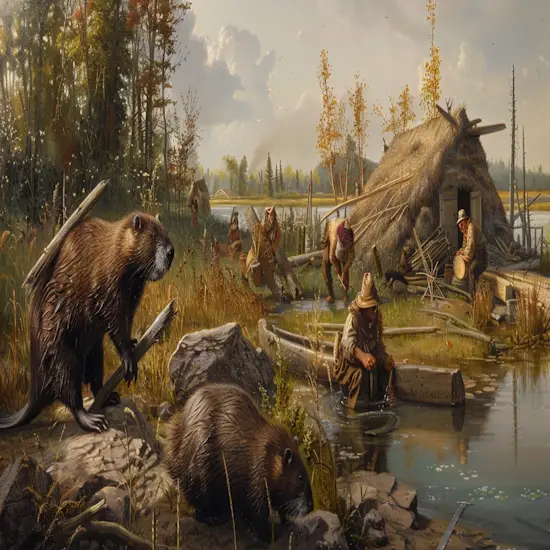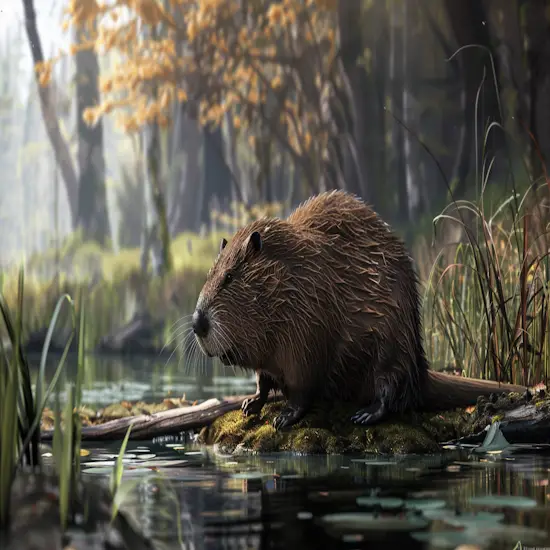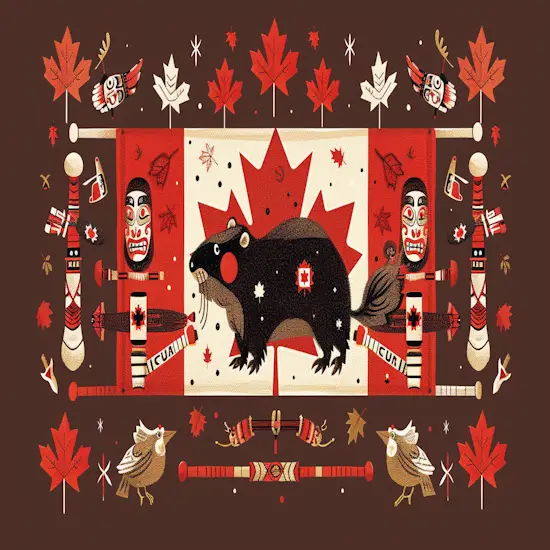Disclosure: We may earn commissions if you purchase products after clicking on a link from our site.
Beavers are essential to Canada for various reasons beyond their cute appearance. These industrious creatures have a significant impact on the environment, economy, and culture of the country. In this article, we explain how are beavers important to Canada, starting with the settlers.

Table of Contents
Key Takeaways
- Beavers create wetland habitats enhancing biodiversity and water quality.
- Their activities support diverse species, from birds to insects.
- Beavers increase species diversity by 33% in influenced areas.
- They aid in ecosystem balance by filtering pollutants and storing water.
- Beavers drove economic development through the fur trade.

Beaver-Induced Biodiversity
Beavers play a vital role in creating wetland habitats, boosting species diversity, and enhancing ecosystem balance. By building dams and lodges, they transform landscapes, providing homes for various plants and animals. Their activities have a ripple effect, positively impacting the overall biodiversity of the environment.
Wetland Habitat Creation
In Canada, the creation of wetland habitats by beavers greatly enhances biodiversity and ecosystem health. Beavers build dams that form ponds, which attract various plants and animals. These wetlands provide homes for a multitude of species, from birds to insects.
The diverse environments fostered by beavers support life cycles and contribute to the overall health of ecosystems. Wetlands act as natural filters, improving water quality by trapping sediments and pollutants. Additionally, the water stored in beaver ponds during wet seasons helps in times of drought.
Species Diversity Boost
Creating wetland habitats through the construction of dams, beavers greatly enhance species diversity in their ecosystems. By creating ponds and wetlands, beavers provide homes and food sources for various species like fish, birds, insects, and amphibians.
These diverse habitats support a 33% increase in biodiversity within beaver-influenced areas. The wetlands also act as nurseries for young fish and provide shelter for numerous plant species.
This boost in species diversity contributes to the overall health and resilience of the ecosystem, creating a thriving environment for a wide range of organisms to coexist and thrive. Beavers play an important role in shaping the biodiversity of their habitats, making them essential for maintaining a balanced and healthy ecosystem.
Ecosystem Balance Enhancement
Enhancing biodiversity through the construction of dams, beavers play a significant role in maintaining a balanced ecosystem. By creating wetland habitats, beavers attract a variety of species. Their dam-building activities increase biodiversity by 33%, providing homes for many plants and animals.
Additionally, beavers help improve water quality by filtering out pollutants, ensuring a healthier environment for all creatures. During droughts, their dams store water, supporting ecosystems in times of scarcity. By mitigating flooding peaks downstream, beavers minimize risks for surrounding habitats.
Their presence as a keystone species has been highlighted in studies, showcasing the crucial role they play in enhancing ecosystem balance and promoting biodiversity.

Historical Economic Contributions
Beavers played a vital role in the Canadian fur trade, driving economic development and shaping early Canadian history. Their fur pelts were highly sought after, influencing fashion trends in Europe and sustaining a thriving industry for centuries.
The demand for beaver pelts remained strong until modern times, highlighting the significant historical economic contributions of these industrious creatures.
Fur Trade Catalyst
The beaver’s role in the fur trade was pivotal in shaping Canada’s early economy. Beaver pelts were highly sought after in Europe, especially for making fashionable top hats. The demand for beaver pelts remained strong until the 20th century.
Both Aboriginal and European hunters played a significant role in supplying the fur trade with beaver pelts. This trade helped in the economic development of Canada, as it provided a valuable source of income for many early settlers.
The fur trade acted as a catalyst for trade and interactions between different groups, shaping Canada’s economic landscape during its early years.
Economic Development Role
To understand Canada’s early economic growth, it’s important to recognize the significant role played by beavers in the fur trade industry. Beaver pelts were highly sought after in Europe, driving the fur trade and aiding in the development of Canada.
The demand for beaver pelts remained strong until the 20th century, with Indigenous and European hunters supplying the trade. The fur trade not only brought economic prosperity but also cultural exchange.
Beaver pelts were even used to make fashionable top hats. This historical economic contribution showcases how beavers played a vital role in shaping Canada’s economic landscape, highlighting their importance in the country’s early development.
Fashion Trends Influence
During the era of the fur trade, beaver pelts influenced fashion trends in Europe, particularly in the creation of stylish top hats. The demand for beaver pelts remained high until the 20th century, with Aboriginal and European hunters supplying the fur trade.
These luxurious pelts were highly prized for their quality and durability, making them a symbol of status and sophistication. The fashion industry’s fascination with beaver pelts not only boosted Canada’s economy but also contributed to the development of the country.
The historical significance of beavers in shaping fashion trends highlights their enduring impact on both the economic and cultural landscape, showcasing their importance in Canada’s history.

Unique Beaver Abilities
Beavers possess remarkable abilities that set them apart from other animals. They can skillfully construct dams using trees up to a meter in diameter, showcasing their impressive construction skills.
With their flat tail, webbed feet, and the ability to stay underwater for up to 15 minutes, beavers excel at underwater woodcutting and adaptive diving.
Beaver Construction Skills
Beaver’s remarkable ability to fell trees up to a meter in diameter showcases their essential construction skills. These skills are crucial for their survival and shaping their environment. Here are some fascinating aspects of beaver construction skills:
- Precision Tree Felling: Beavers can accurately fell large trees to build dams and lodges.
- Building Dams: They construct intricate dams using wood, mud, and rocks to create ponds.
- Lodge Construction: Beavers create cozy lodges with underwater entrances for protection.
- Channel Creation: They can divert water flow by digging canals and altering landscapes.
Be amazed by the beaver’s architectural prowess and their ability to transform their surroundings for the benefit of their ecosystem.
Underwater Woodcutting Techniques
To excel at cutting wood underwater, these industrious creatures have developed unique techniques that showcase their impressive adaptability and survival skills. Beavers possess remarkable abilities that enable them to efficiently manipulate wood beneath the surface. Here’s a closer look at some of their extraordinary underwater woodcutting skills:
| Woodcutting Technique | Description | Purpose |
|---|---|---|
| Incisor Teeth | Specially adapted for cutting | Efficiently fell trees |
| Transparent Membranes | Protect eyes while submerged | Maintain visibility |
| Webbed Feet | Aid in swimming and maneuvering | Navigate through water easily |
| Tail Slap | Signals danger or territory | Communicate with other beavers |
| Dragging Mechanism | Drag materials underwater | Transport building materials |
Adaptive Diving Features
With their unique diving features, these industrious creatures showcase remarkable adaptability and survival skills underwater.
- Exceptional Swimmers: Beavers possess webbed feet and a flat tail, making them excellent swimmers.
- Extended Underwater Stay: They can stay submerged for up to 15 minutes, thanks to their physiological adaptations.
- Wood-Cutting Expertise: Their incisors allow them to cut wood underwater, aiding in lodge and dam construction.
- Protective Eye Membranes: Beavers have protective membranes enabling them to keep their eyes open underwater, facilitating navigation and gathering of building materials.

Cultural Significance
Beavers hold great cultural significance in Canada through Indigenous uses, folklore, and national symbol debates. Indigenous peoples relied on beavers for sustenance and regarded them as part of the natural ecosystem. Beavers were respected animals, with their role extending beyond practical uses to folklore and symbolic representation.
Indigenous Uses of Beavers
Indigenous peoples have long valued beavers for their cultural significance and practical uses.
Indigenous Uses of Beavers:
- All-Encompassing Use: Indigenous communities utilized all parts of the beaver for various purposes.
- Winter Food Source: Beaver meat was an essential food source during harsh winter months.
- Respect for Nature: Beavers were revered as part of the natural world, emphasizing harmony with the environment.
- Totem Animals: Beavers held symbolic importance as totem animals in Indigenous cultures.
Beavers in Folklore
Building upon the traditional significance of beavers to Indigenous communities, folklore surrounding these industrious creatures has been passed down through generations, embodying cultural relevance across various narratives.
In folklore, beavers are often depicted as symbols of hard work, determination, and family unity. Stories portray beavers as clever builders, constructing elaborate dams and lodges with precision and skill. Some tales even attribute mystical powers to beavers, portraying them as guardians of rivers and protectors of nature.
Through these cultural representations, beavers have become emblematic of resilience, cooperation, and the importance of living in harmony with the environment. Their presence in folklore serves to emphasize the enduring respect and admiration that people hold for these remarkable animals.
National Symbol Debate
In the ongoing debate over Canada’s national symbol, the beaver’s cultural significance is being examined closely. Here are some key points to ponder:
- Historical Importance: Beaver pelts were vital in the Canadian fur trade and played a significant role in the country’s development.
- Indigenous Connection: Beavers were indispensable to Indigenous peoples, who utilized all parts of the beaver and revered them as part of the natural ecosystem.
- National Identity: Beavers symbolize Canadian qualities like warning others of danger, being herbivores, and sharing lodges with muskrats.
- Defining Canadian Traits: The beaver’s adaptation to the environment mirrors Canadians’ ability to thrive in diverse landscapes through unique characteristics.

Environmental Impact and Management
Beavers play an essential role in creating wetland habitats that support a diverse range of species. They also help mitigate floods by building dams that control water flow, and their ability to store water aids in resilience during droughts. The management of beaver populations is vital in preserving these environmental benefits for the overall health of ecosystems.
Wetland Habitat Creation
Creating wetland habitats through the actions of beavers is essential for maintaining ecosystem health and biodiversity in natural environments. Beavers play an important role in shaping their surroundings to benefit various species and the ecosystem as a whole. Here are some key points to keep in mind:
- Beavers create diverse wetland habitats that support a wide range of plant and animal species.
- These habitats increase biodiversity by providing unique niches for different organisms to thrive.
- Wetlands formed by beavers help filter pollutants and improve water quality in the ecosystem.
- By storing water during droughts and creating new habitats, beavers contribute significantly to the overall health and resilience of the environment.
Flood Mitigation Roles
To manage floods and protect ecosystems, beavers actively contribute by utilizing their natural abilities to create dams and regulate water flow. Beavers play a vital role in flood mitigation by building dams that slow down water movement, reducing flooding downstream.
The dams also help to store excess water during heavy rainfall, which minimizes the risk of flooding during peak times. By strategically placing woody debris in streams, beavers can redirect water flow and prevent erosion.
Their engineering skills create wetland habitats that act as natural sponges, absorbing water and decreasing flood intensity. Overall, beavers serve as nature’s engineers, effectively managing flood risks and maintaining the balance of ecosystems.
Drought Resilience Support
For maintaining ecological balance and addressing water scarcity challenges, harnessing the natural capabilities of beavers proves essential in bolstering drought resilience within ecosystems. Beavers contribute to drought resilience by:
- Creating Wetland Habitats: Beavers build dams that help retain water during dry periods.
- Increasing Water Storage: Their dams and lodges store water, providing a buffer against drought.
- Improving Water Quality: Beavers filter and purify water, making it more available during droughts.
- Promoting Biodiversity: By creating diverse habitats, beavers help promote the survival of various species during times of water scarcity.
The Bottom Line
How are beavers important to Canada? Going back to the early days of the settlers until now, beavers have played a major role in the economy, environment, and culture of Canada. In this article, we roll back the years and explain how beavers are important to Canada.
If you want to improve your beaver hunting skills or get into hunting beavers, then you can also read how to hunt beavers, how to hunt beavers at night, and how to attract beavers.
